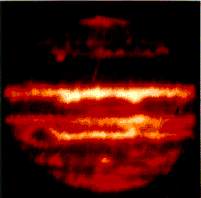This is a drawing that shows the history of the inside of a giant planet.
Click on image for full size
Image from: The New Solar System
How the Interior of Neptune Formed
The drawing shows a possible history of the inside of giant planets.
As the planets drew material from the solar cloud, bits of heavy rock collected inside the forming planet, as shown in figure A.
Once the planet finished forming, these heavy bits of rock fell into the middle of the planet, as illustrated in figure B.
As shown in the picture, the gas part of the planet is much bigger than the rocky part. That is because the amount of gas and ice which came to Neptune in the beginning, depended upon where Neptune was in the original solar cloud.
Eventually, the heavy, rocky material at the center became a core, as illustrated in figure C.
Leftover heat from this process of Neptune's forming may still influence the motions in Neptune's atmosphere.
You might also be interested in:

Scientists think that the solar system formed out of a spinning cloud of hydrogen and helium gas. Because the cloud was spinning, it flattened into a frisbee shape, just like a ball of pizza dough becomes
...more
The picture shows places on Jupiter which are hot. Jupiter is a very warm body in space, as shown in the picture, and this warmth is associated with the energy of Jupiter. Neptune has also been found to
...more
Motions in the interior of a gas-giant planet such as Neptune may be very different from the motions within the Earth. A second idea for the motions in the interior of a gas-giant planet is shown in this
...more
Motions in the interior of a planet help carry heat from the inside to the outside. The drawing to the left illustrates a kind of global motion that is typical of motions in the atmosphere as well as interior
...more
This image shows the new Great Dark Spot of Neptune, which was discovered using the Hubble Space Telescope. The image shown here, shows a "hole" in the clouds of Neptune in pink, in the northern hemisphere,
...more
The giant planets have definitely changed since their formation. But how much remains to be seen. Most of the original air of the giant planets remains in place. (The earth-like planets lost most of their
...more
This image shows some clouds known as "cirrus" clouds, extending for many kilometers across the face of Neptune. These clouds are very high up, for they can be seen to cast shadows on the lower clouds,
...more
This image of Neptune uses false colors to show where the smog is. The smog of Neptune can be seen in red along the edge of the image. These hazes of smog are found at very high altitudes, over the clouds
...more















